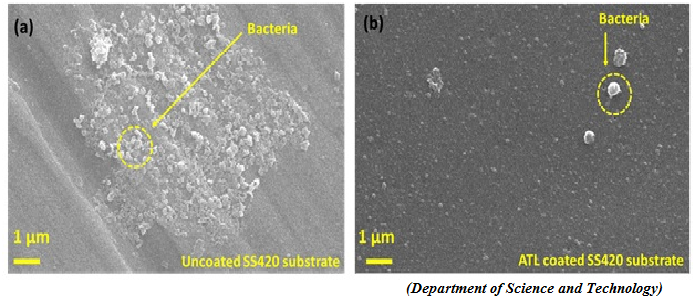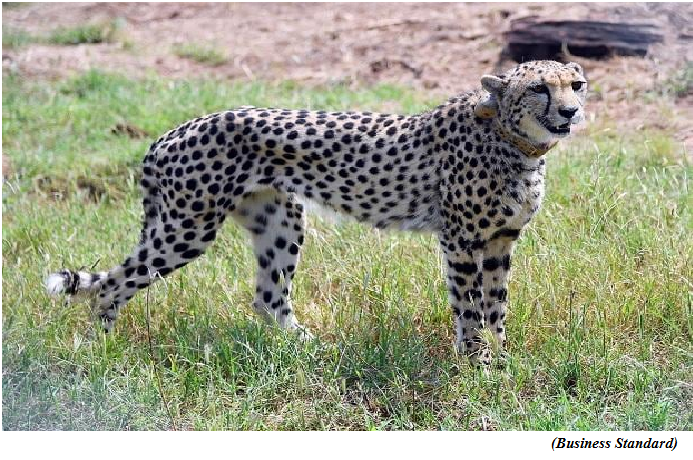Unique non cytotoxic nanocomposite coatings developed to prevent post surgical infections (GS Paper 3, Science and Tech)

Why in news?
- A newly developed nanocomposite coating can inhibit biofilm formation and also kill attached bacteria, thereby helping tackle growing post-operative infections, a common occurrence these days due to antibiotic resistance in bacteria,
Why it matters?
- These post-operative surgical site infections (SSIs), which according to WHO, affect 11 percent of patients in low and middle-income countries, are caused by the development of biofilms (groups of bacteria growing in formation that are highly resistant to antibiotics) on the incision site or in the soft tissue inside the site.
- The biofilm matrix, which may come from existing infections in the patient’s body or can be transferred from the hospital environment through potential carriers like surgical equipment, wound dressing, or bandage/surgical sutures, acts as a physical shield against antibiotics given during the operation, slowing down their penetration.
- Hence, it is important to have an antibacterial coating on the surface of these materials that can act as potential sources of SSI.
Non-cytotoxic materials:
- Conventionally antibacterial coatings containing biocides like nanosilver, nanocopper, triclosan, and chlorhexidine have been used to prevent bacterial infections.
- Although, Triclosan and chlorhexidine exhibit antibacterial effects towards a broad-spectrum of bacteria, they and other biocides are found to produce cytotoxicity. As a result, there is an increasing focus on developing alternative non-cytotoxic materials with antibacterial properties.
New research:
- Researchers from ARCI have developed a nanocomposite coating ((named as ATL)) by combining water repellence and biocidal property (combinatorial approach), which exhibits both hydrophobic and biocidal behaviour.
- The developed coating not only inhibits biofilm formation by restricting bacterial and water adhesion but also kills attached bacteria.
- The ATL-coated vicryl sutures exhibited higher percentage biofilm inhibition when compared to commercially available triclosan-coated antibacterial sutures.
- Cytotoxicity of the formulation was evaluated on coated surface, and it was found that ATL coatings are non-cytotoxic.
Way Forward:
- The coatings developed in the present study can be used as a non-cytotoxic alternative to the commercially available antibacterial coatings, especially for healthcare applications on surgical sutures/surgical instruments to prevent the rise of multidrug-resistant bacteria.
South Africa Translocates 12 Cheetah to India
(GS Paper 3, Environment)
Why in news?
- Recently, twelve cheetahs departed from South Africa for India as part of an initiative to expand the cheetah meta-population and to reintroduce cheetahs to a former range state following their local extinction due to over hunting and loss of habitat in the last century.
- The cheetah will join eight of the mammals relocated to India’s Kuno National Park from Namibia in September 2022.

MoU in 2023:
- Earlier, the governments of South Africa and India signed a Memorandum of Understanding (MoU) on Cooperation on the Re-introduction of Cheetah to India.
- The MoU facilitates cooperation between the two countries to establish a viable and secure cheetah population in India; promotes conservation and ensures that expertise is shared and exchanged, and capacity built, to promote cheetah conservation.
- This includes human-wildlife conflict resolution, capture and translocation of wildlife and community participation in conservation in the two countries.
Why restoring cheetah population in India?
- Restoring cheetah populations is considered by India to have vital and far-reaching conservation consequences, which would aim to achieve a number of ecological objectives, including re-establishing the function role of cheetah within their historical range in India and improving the enhancing the livelihood options and economies of the local communities.
- Following the import of the 12 cheetahs in February, the plan is to translocate a further 12 annually for the next eight to 10 years. Scientific assessments will be undertaken periodically to inform such translocations.
About the Cheetah:
- The Cheetah, Acinonyx jubatus, is the world’s fastest mammal, and is endemic to the savannahs of Africa. While southern Africa is the cheetah’s regional stronghold, it is considered to be a vulnerable under the Convention on International Trade in Endangered Species of Wild Fauna and Flora (CITES) and is listed in Appendix I.
- The cheetah was declared extinct in India in 1952.
Population in South Africa:
- Worldwide, cheetah numbers have declined from an estimated 15 000 adults in 1975 to a current global population of less than 7, 000 individuals. In South Africa, the transition to democracy had substantial implications for wild cheetah conservation.
- The Cheetahs were kindly made available by Phinda Game Reserve (3), Tswalu Kalahari Reserve (3), the Waterberg Biosphere (3), Kwandwe Game Reserve (2) and Mapesu Game Reserve (1) and their translocation is in line with IUCN Guidelines for Reintroductions and Other Conservation Translocation and in accordance with international veterinary standards and protocols.
Why China Russia are using balloons in the age of satellites and drones
(GS Paper 2, International Relation)
Context:
- The United States has a defence budget of a whopping $1.90 trillion, China spent over $200 billion on its military as per 2021 data, and Russia, which is engaged in a deadly war with Ukraine, pegs its defence budget at $84 billion.
- The three countries are equipped with state-of-the-art weaponry, cutting-edge defence technology, and superior tactical maneuverability. But, over the past three weeks, these countries have been engaged in a confrontation over balloons.

Recent incidents:
- The United States has suddenly seen a surge in sightings of alleged spy balloons above its mainland after it downed one belonging to China recently.
- Meanwhile, Russia has also been using a similar strategy in its war with Ukraine, and nearly half a dozen such spy balloons were reported over Kyiv.
- Primary findings suggested that the objects were balloons floating in the wind, which could have been equipped with intelligence equipment or reflectors.
Background:
- Balloons are not new in the field of war, they have been around since World War II and what makes them special is that they can operate at 24,000-37,000 meters above the ground.
- These mega-structures have been around even before the Wright brothers made their first flight 1903. The first hydrogen gas-filled balloon flew above Paris way back in 1783 and since then these vehicles have evolved and have been repurposed to suit various requirements.
- Just after the end of World War II, the US military started exploring the use of high-altitude spy balloons, which led to a large-scale series of missions called Project Genetrix. The project flew balloons for photography over Soviet bloc territory in the 1950s.
Technology advancement:
- The altitude that these balloons fly at is well above where commercial air traffic operates.
- The Sanriku Balloon Centre (SBC) in the north of Japan created history in 2022 when it quietly flew a balloon nearly 53 kilometers above the surface of the Earth. Another 47 kilometers and the balloon would have touched the Karmen line, the boundary between Earth and space.
- Over the years, several companies have perfected the system of balloons that can be deployed for multipurpose approaches, from scientific studies to understanding atmospheric composition to conducting aerial reconnaissance to gathering intelligence.
- With improvements in technology, the balloons have also been modified for longer missions powered by solar energy.
Cheaper than Surveillance Satellites:
- A surveillance satellite, while effective, is not an easy thing to launch. From development to integration, to launching to operations, satellites not only require constant manpower but also a continuous flow of financial resources.
- Balloons, on the other hand, are cheaper to not only manufacture, but also operate. The turnaround time is also significantly shorter.
- SpaceX takes about five days to ready a launchpad for two successive launches. As compared, balloons can be deployed with a shorter window, making them cheaper and viable.
UAV vs. Ballon:
- Unmanned Aerial Vehicles (UAVs) have been one of the most successful innovations when it comes to military aerial reconnaissance.
- But they come with their own disadvantages when compared with these balloons. The UAVs are able to fly at just 5,500 meters above Earth against balloons that go up to 37,000 meters.
- Another advantage these balloons pose is their quiet approach in the air as against the humming of the drones. However, drones do have a significant advantage of firepower and dropping heavy ammunition when required.
Conclusion:
- As the art of warfare evolves, the balloons could pose a major challenge to countries as they sneak in across the borders from above, do their business, and quietly disappear.




